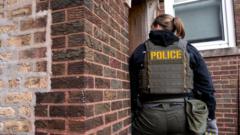Tensions remained high over the Easter weekend as Russian forces continued to launch attacks despite a promised truce, leading to intensified military responses from Ukraine.
Easter Truce in Ukraine Broken by Renewed Fighting

Easter Truce in Ukraine Broken by Renewed Fighting
Despite a declared cease-fire by Russia, Ukrainian President Zelensky reported ongoing hostilities along the front lines, casting doubt on Moscow’s peace intentions.
On the morning of April 20, 2025, President Volodymyr Zelensky of Ukraine reported that Russian military action persisted even after Moscow announced a 30-hour cease-fire for Easter. Ukrainian forces faced relentless artillery fire, including nearly 450 rounds and multiple drone strikes, totaling over 300. Much of this disruption occurred within the first hours of the supposed truce, illustrating a stark contrast between Russia's declaration and real-time aggression.
Zelensky noted that violence was particularly evident in regions like Kursk and Belgorod, where Russia aimed to regain previously lost ground. “As of this morning, it appears that the Russian Army is making token gestures of a cease-fire while simultaneously carrying out attacks,” Zelensky stated.
The tenuous cease-fire order had come from Russian President Vladimir Putin shortly before it was to take effect, ostensibly to signal to the Trump administration that Russia was amenable to peace negotiations. However, skepticism among Ukrainian officials regarding Russia’s sincerity prevailed. Zelensky emphasized his troops' readiness to respond exactly in kind to Russian actions, insisting, “If the enemy attacks, we will retaliate accordingly."
The cease-fire announcement followed frustration from U.S. officials regarding Russia’s refusal to agree to a 30-day cease-fire proposal that Ukraine had initially accepted. In remarks that highlighted growing tensions, Secretary of State Marco Rubio suggested the U.S. might reconsider its approach to the instability in Ukraine. Trump also indicated a willingness to reassess U.S. engagement based on the actions of the involved parties.
On Easter Sunday, Zelensky urged for an extension of the truce, signaling Ukraine's continued openness to negotiations despite the challenging circumstances.
As the situation unfolds, the divide between declarations and military actions poses significant challenges for peace efforts in the ongoing conflict.
Zelensky noted that violence was particularly evident in regions like Kursk and Belgorod, where Russia aimed to regain previously lost ground. “As of this morning, it appears that the Russian Army is making token gestures of a cease-fire while simultaneously carrying out attacks,” Zelensky stated.
The tenuous cease-fire order had come from Russian President Vladimir Putin shortly before it was to take effect, ostensibly to signal to the Trump administration that Russia was amenable to peace negotiations. However, skepticism among Ukrainian officials regarding Russia’s sincerity prevailed. Zelensky emphasized his troops' readiness to respond exactly in kind to Russian actions, insisting, “If the enemy attacks, we will retaliate accordingly."
The cease-fire announcement followed frustration from U.S. officials regarding Russia’s refusal to agree to a 30-day cease-fire proposal that Ukraine had initially accepted. In remarks that highlighted growing tensions, Secretary of State Marco Rubio suggested the U.S. might reconsider its approach to the instability in Ukraine. Trump also indicated a willingness to reassess U.S. engagement based on the actions of the involved parties.
On Easter Sunday, Zelensky urged for an extension of the truce, signaling Ukraine's continued openness to negotiations despite the challenging circumstances.
As the situation unfolds, the divide between declarations and military actions poses significant challenges for peace efforts in the ongoing conflict.





















